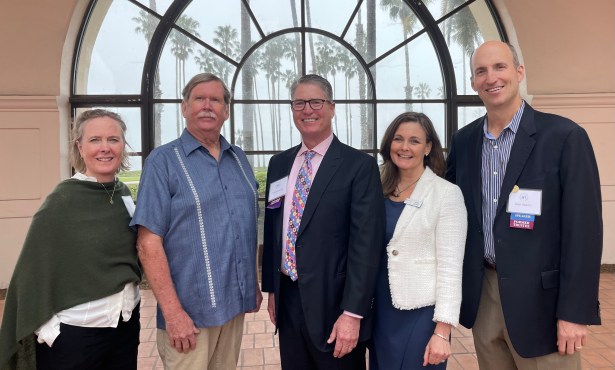Contraptions and Sound Ideas
Trimpin Brings His Musical Machines to Ojai
by Josef Woodard
Last year at the historic, ever-provocative Ojai Music Festival,
the unexpected highlight of the festival came early, when the
Bugallo-Williams piano duo performed dazzling live human
transcriptions of the “Studies for Player Piano” by Conlon
Nancarrow. The celebrated, late, great American innovator created
remarkable and complex music from the 1940s through his death in
1997, painstakingly punching out rolls for his player pianos in his
Mexico City home, where he expatriated after suffering political
and musical oppression.
Ojai’s tribute to Nancarrow continues at this year’s festival,
running from June 8-11, mostly at Ojai’s Libbey Bowl. This year’s
Nancarrow homage comes courtesy of one of his most famous fans, the
unique composer, and installation and sound artist, Trimpin.
Tonight at Libbey Bowl, Trimpin will “perform” some of Nancarrow’s
human musician-defying scores with an elaborate apparatus that
takes the data from Nancarrow’s original rolls and “plays” them,
via the computer MIDI language, on a grand piano for a live
audience to hear. Trimpin also presents his interactive
installation piece “Conloninpurple” at the Ojai Valley Museum.
Though he remains an ardent champion of Nancarrow’s music,
Trimpin is becoming evermore a name to be reckoned with on his own.
“Once in a while, when I’m asked — like at Ojai — I perform his
work on a regular piano, but lately, I’m more involved in public
artwork and different kinds of installations, not just related to
Nancarrow’s work.”
Trimpin (he has just gone by one name for many years) recently
spoke from his workshop in Seattle, a space where he spends long
hours tinkering with concepts, circuitry, and other implements and
materials of a new kind of sound-art sculptor.
Considering your interest in music, machinery, and
inventing your own methods, it makes sense that you would naturally
become fascinated with Nancarrow’s work. Was it something of a
“light bulb” moment when you discovered his music? Yeah.
When I heard it for the first time, in the late ’70s, it was on a
radio program. I could immediately hear that this music was more
spatial music and that’s what Nancarrow always tried to do — to
have it more separated. But, of course, he could only use player
pianos. I was immediately fascinated with his music, which was the
reason I got in contact with him. In the beginning, he was a little
bit suspicious. He said, “Well, other people have tried before to
transcribe this information in a computer database.” But of course,
they used the scores he was writing, and the scores are not really
representing the time information that was punched into the paper
roll. It was too difficult to transcribe it from the notation into
a computer program. That’s the reason I used the original player
piano rolls to capture this information in real time.
It is part of the fabric of your art to design the
machinery on which the music and sound are made, isn’t it?
Right. Since you cannot get this commercially or buy it off the
shelf, you really have to invent and develop this kind of machinery
so it can do what you’re trying to do, and not be limited to
whatever an engineer was thinking would be enough.
You are also presenting “Conloninpurple,” an interactive
sound installation at the Ojai Valley Museum. Can you explain what
that is about? That is based on five octaves, 60 different
pitches, of wooden bars. It’s almost like a xylophone. These tuned
wooden bars also have specially tuned resonators on top.
“Conloninpurple” is an installation where you are walking through
the instrument, and it surrounds you. So you can have acoustical
movements going on. They are above your ear, below your ear level,
or in different locations. It’s exploring the sound-in-the-round
phenomenon. Also, the visitor can play the instrument and explore
what’s going on when you move the sound through space. It’s named
after Conlon Nancarrow. I once asked him what his favorite color
was and he said purple.
You’ve had such a unique artistic life, so far. Has it
proceeded in a way that has surprised you? Well, certain
projects go on for years and years. It’s mostly like
work-in-progress. Since I have to do everything on my own, that’s
the reason it’s a slow process of developing certain ideas. It
takes time and one project sometimes feeds other ones. I’m always
working on multiple projects simultaneously. Sometimes, it takes a
year or two to complete an idea, from the concept to the finished
project. I’m doing a lot of musical scores, graphical scores, but
they turn into installations. Each piece has a score. Everything is
written. Of course, it’s a little bit different than the
conventional score, but that’s what my work was always based on —
building the instrument and composing for it.
Is part of your artistic process similar to that of an
inventor and an engineer, solving problems in creating the
piece? Right, but I don’t really see myself, really, as an
engineer or as an inventor. Of course, I always have to learn on
the job. It’s more like realizing the concept and, in doing so, you
have to learn how to drill holes or build this kind of instrument.
All of the disciplines are somehow involved.
4•1•1 Trimpin’s machine will perform selected
“Studies for Player Piano” by Conlon Nancarrow, Thursday, June 8,
at 8 p.m., in Ojai’s Libbey Bowl. Trimpin also shows his
interactive installation “Conloninpurple,” at the Ojai Valley
Museum. Call 646-2094 or visit ojaifestival.org.



